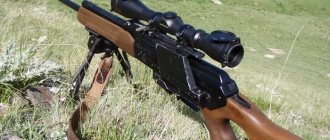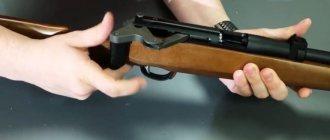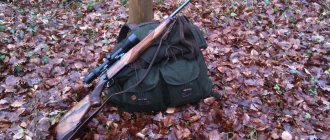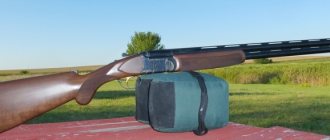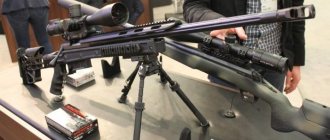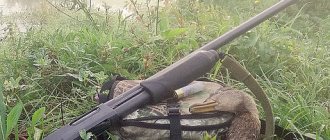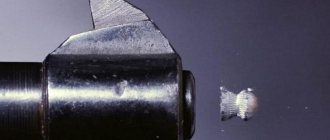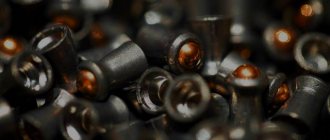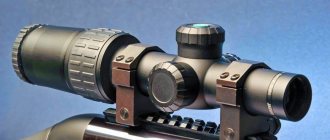History of appearance
The 30-06 cartridge was adopted by the United States of America in 1906 (hence the 06 in the name). Initially, the projectile was supposed to be a replacement for the outdated .30-03 model of 1903. However, during the First World War, the projectile showed only its best side, so that within a few years its first modifications were developed with the .30 M1 Ball bullet (11.3 grams), as well as the .30 M2 Ball bullet (9.7 grams) ).
In 1936, the United States adopted the M1 Grand self-loading rifle, which subsequently became the most popular weapon for firing 30-06 Sprg cartridges. No less popular was the modification of the T20 rifle, which is the same M1 Grand, but with a detachable magazine for 20 rounds, as well as the ability to fire in bursts (part of the design was copied from the Browning Bar M1918).
After the end of World War II, the United States began to create a new ammunition, which was supposed to retain all the ballistic properties of the .30-06 cartridge, but at the same time be smaller. This is how a projectile called the T-65 was born, which later became known as 7.62x51 mm and was adopted by NATO. In fact, it remained the same Springfield, but with a bullet shortened by 12 millimeters, as well as more modern gunpowder.
In 2000, all gun factories that produced .30-06 and T-65 cartridges switched to using new gunpowder, thanks to which the old projectile also improved its technical characteristics. Experts say that it has even become more powerful than the .308 caliber (by about 20%), so that many hunters began to switch from 7.62x51 to 7.62x63. The Barnaul Machine Tool Plant also became interested in the caliber and acquired a patent for the production of sporting and hunting ammunition.
"Springfield"
The .30-06 Springfield is a 7.62 mm format ammunition. US Army soldiers armed themselves with it in 1906 for shooting from the Springfield rifle, and in 1936 they began to use it in the Garand rifle.
In general, the numbers .30-06 mean the 0.30-inch caliber of the 1906 model. The warhead was in operation for more than fifty years. It was later replaced by NATO products 7.62X51 and 5.56X45 mm.
By the way, the .30-06 format is respected by hunters in both South and North America.
| Caliber | Bullet weight, g | VO m/s | EO Joules |
| .30-06 | 7,1 | 1030 | 3766 |
| .30-06 | 9,7 | 890 | 3842 |
| .30-06 | 11,7 | 825 | 3982 |
| .30-06 | 14,7 | 735 | 3863 |
A universal caliber for athletes and hunters
Why is the .30-06 considered a universal cartridge, equally effective for both recreational hunters and professional athletes? The reason for this can also be found in history. After the end of World War II, both social groups were in dire need of new ammunition. For sports enthusiasts, it was important to find a projectile that would ensure accuracy of combat, while hunters needed ammunition with good penetrating ability. It so happened that both of these characteristics were present in the 7.62x63 mm cartridge, so that fishermen and athletes paid attention to it almost simultaneously.
Although the .30-06 Sprg is considered only the third most popular rifle caliber in the American civilian market (after .308 Win and .223 Rem), many gun owners prefer it because it can be used for both hunting large game, and for training target shooting. At the same time, the cost of ammunition remains at a quite acceptable level, and the popularity of the cartridge among the civilian population is only increasing every day.
Weapons chambered for 7.62x63 mm
Quite a lot of weapons were chambered under the well-known and excellent Springfield cartridge. The most famous models of small arms are:
- Winchester Model 1895;
- Remington Model 30;
- Browning M1917;
- Browning M1919;
- BAR M1918;
- Johnson M1941;
- Johnson M1914 LMG;
- M1 Garand;
- Chauchat M1915;
- Springfield M1903;
- MR-18MN;
- VPO-102 "Vepr-Hunter".
After the start of production of the Springfield combat cartridge, mass production of the sporting and hunting version of the cartridge also began. Among the hunting class, the cartridge did not gain popularity immediately, but almost 10 years later - at the end of the 20-30s of the last century. A hunting carbine was created on the basis of an army rifle chambered for 7.62x63, and the first rifle for it was the Winchester Model 1895 (it went on sale in 1908). The first bolt-action rifle chambered for this cartridge, the Remington Model 30, hit the market in 1921.
Cartridge 7.62x63 Springfield Remingtom premier Safari
Strengths of the .30-06 Springfield
To understand whether it is worth buying a unitary cartridge for hunting and sports, or whether it is better to give preference to the .308 Win caliber, it is recommended to study the list of positive qualities that the .30-06 Sprg boasts:
- Prevalence. Many arms companies make self-loading carbines and bolt-action rifles chambered specifically for the .30-06 cartridge (or at least make modifications for this projectile). Fans of outdated rifles should definitely choose this caliber, since it is used more often than other cartridges on old weapons.
Golden Bear Ammo Box, .30-06 Springfield
- Versatility. The .30-06 cartridge is equally effective for both target practice and wild boar hunting. The secret to this is simple - excellent penetrating ability combined with high accuracy. At the same time, the buyer will have a choice between light ammunition, sharpened for shooting at long distances, as well as heavy ammunition, which has better combat sharpness.
- Excellent combat characteristics. The reason for this lies in the rather large size of the cartridge case, which holds more powder charge, which means that the bullet will not only fly faster, but also impact harder. At a distance of up to 300 m, the old Springfield completely outperforms the .308 Win, having a much higher muzzle velocity and muzzle energy.
- Wide range of models. The RWS company offers customers a whole range of rifle cartridges with different powder weights, as well as different tips. For example, there are H-jacket bullets or Superformance ballistic projectiles (solid bullets). The choice will please not only hunters, but also athletes, who will be able to purchase a lightweight version of the .30-06 cartridge, which has greater accuracy at medium distances.
- Rich story. If you want to use the ammunition your ancestors shot, or you're just curious about what the soldiers fought with during World War I, the .30-06 is a great choice. This cartridge is 50 years older than the famous .308 Winchester, so it will be much more interesting for a history buff to use. Especially if you use a projectile for shooting from an old nozzle.
And these are just the main positive aspects that the .30-06 caliber can boast of. Why, in this case, has it not yet overtaken the .308 Win in popularity? For the Russian hunter, the reason lies in the cost of the shell, which averages 167 rubles per piece. And although this price is considered quite acceptable for a hunting cartridge, many do not want to overpay, because 7.62×51 can be purchased for only 50 rubles.
Encyclopedia of weapons
Cartridge .30-06 Springfield / 7.62x63, 1906, USA
Tactical and technical characteristics .30-06 Springfield (7.62x63)
Caliber - 7.62 (.30-06 Springfield) Length, mm - 84.5 Case weight, g - 25.5 - 27.25 Bullet weight, g - 9 .70 - 10.5 Powder charge weight, g - 3.0 - 3.4 Initial bullet speed, m/s - 820 - 976 Muzzle energy of the bullet, J - 3200 - 4126
The cartridge appeared in the USA in 1906 as a military cartridge for use with the Springfield Model 1903 rifle. It had a bullet with a rounded tip and in the black powder version was called .30–45, and over time received the designation .30–06, under which currently the cartridge appears in most sources.
At a time when repeating infantry rifles were still of great military importance, the Americans were already looking for a weapon and cartridge to replace their .30-40 Krag cartridge, which in 1892, together with the Krag-Jorgensen rifle, was adopted by the US Army as the first small-caliber, a live cartridge filled with smokeless powder.
Cartridge 7.62x63 / .30-06 Springfield
In 1903, Sprigfield completed the development of a new repeating rifle, and the Springfield 1903 model could be introduced into all branches of the military.
The new rifle was chambered in the .30-03 Springfield cartridge with a 14.3 gram full jacket round nose bullet that quickly became known for its superior accuracy.
The undeniable advantage of the .30-03 Springfield cartridge over its predecessor, the .30-40 Krag cartridge, which had a case with a protruding rim, was the new wafer case design. It facilitated the use of the cartridge in weapons with a box magazine and locking by turning the bolt. However, with the advent of the new cartridge, the disadvantages of the heavy round-head bullet used in it also appeared.
The 14.3 g bullet lacked staying power. A problem also known to German specialists with 8×57 IS cartridges, which were equipped with a bullet weighing 14.7 g with a round head. In 1904/05, German designers found a solution to this problem in a pointed bullet weighing 10 g, and its dimensions were even better suited to the profile of the barrel.
.30-03 Springfield (top) .30-06 Springfield (bottom)
Experts from Springfield came to an almost identical solution. They modified the old .30-03 Springfield cartridge, which had only lasted 3 years, using a 9.7g full-jacketed pointed bullet while slightly altering the case (reducing the muzzle length by 2mm). Thus, adopted in 1906 (which, in fact, explains the presence of the number “06” in the designation), the cartridge turned into one of the most powerful combat cartridges, comparable to the German 8x57 IS.
A bullet weighing 9.7 g, fired from a barrel 610 mm long, developed an initial speed of about 820 m/s. But the parameters of the Springfield 1903 rifle barrel (254 mm rifling pitch) were not optimal for this relatively light bullet. This explains the fact that in 1926 a modified version of the cartridge was accepted for supply, designated “Ball, Caliber 30, Ml,” with a full-shell pointed bullet weighing 11.1 g with a conical shank. The new version of the equipment corresponded to the speed of a light bullet, i.e. exactly 820 m/s. After some time, a slightly weakened version appeared with an initial speed of exactly 800 m/s.
In 1940, they returned to a full-shell pointed bullet weighing 9.7 g, the initial speed of which reached 835 m/s. This variant of the .30-06-Springfield cartridge, which became standard during World War II, is designated "Cartridge, Ball, Caliber 30, M2". The main reason for the new change in equipment option was the adoption of the self-loading Garand rifle.
In the 1950s, the .30-06 Springfield cartridge (7.62x63) was replaced as a standard cartridge by the .308 Winchester cartridge (NATO cartridge 7.62x51) and the military service of the .30-06 Springfield cartridge ended, which, however, , from the very beginning began to be used as a hunting cartridge. In Central Europe it was designated as the 7.62x63 cartridge.
Almost simultaneously with the appearance of the combat model, mass production of sporting and hunting versions of the cartridge began, and a hunting carbine was created on the basis of an army rifle. However, as a hunting cartridge, the .30-06 cartridge started quite slowly. The first hunting rifle chambered in .30-06 was the Model 1895 Winchester with a Henry brace.
It went on sale in 1908. The hunting carbine with a longitudinally sliding bolt entered the market only in 1921. It was a Remington model 30. But after 5-10 years, American gun manufacturers began to offer different models of hunting carbines chambered for .30-06 cartridges. The peak of its popularity in America occurred in the late 1920s and 1930s.
The .30-06 cartridge turned out to be extremely well balanced. (Balance means the impeccable functional compatibility of all elements of the cartridge - the coincidence of the required chamber capacity of the cartridge case and the diameter of the bullet, the length of the barrel, the slope angle of the cartridge case and other nuances, which together make up a cartridge that is either wonderful, or so-so, or one that everyone forgets about a couple of seasons).
The dimensions and shape of the 63 mm long wafer brass sleeve turned out to be close to optimal, allowing it to accommodate a fairly powerful charge of gunpowder (2.4-3.9 g), accelerating a bullet with a diameter of 7.82 mm and a weight of 9.7 g to a speed of 825 m /With; the initial flight speed of a bullet weighing 11.7 g is 820 m/sec and a heavy 13-gram bullet is -790 m/sec. And at the same time, the overall dimensions of the cartridge remained within reason, without requiring an increase in the length of the bolt and the weight of the rifle.
One of the most attractive features of the .30-06 cartridge is that the cartridge case's capacious powder chamber allows it to be successfully combined with the entire imaginable range of 7.62 mm bullets - from 6.5 g to 14.3 g and even 16 g (but This range is only possible with hand-held equipment), giving the hunter a very versatile tool for the widest range of hunts.
A great feature of the .30-06 is its suitability for all modern hunting rifle bolt systems. With the .30-06 chamber, semi-automatic and bolt-action carbines are produced, modernized rifles with a Henry bracket and with a ColT movable forend (pump-action systems).
There are even single-shot bolt-action Ruger systems on the market. Thanks to the moderate working pressure, the 30-06, despite the lack of a rim, has taken root well in the European niche of combined weapons.
Experiments with the .30-06 cartridge case by many companies and amateur craftsmen in the USA were so successful that years later they found a cautiously conservative understanding even on the part of manufacturing giants - Winchester and Remington. And in the catalogs of ammunition manufacturing companies, such “wildcats” based on the .30-06 cartridge case as 25-06, .270 Win., .280 Rem., .338-06 and .35 Wheelen appeared and became legalized.
Cartridges of this caliber are manufactured by most companies around the world. They are very cheap and are especially popular in North and South America, where they are used to hunt a wide variety of game.
.30-03 Springfield - hunting - Winchester (top) - combat - UMC (bottom)
The variety of bullets used for loading (jacketed, semi-jacketed, expansion, controlled expansion, proprietary) can only be compared with the .308 Winchester cartridge. The weight of commercial cartridge bullets ranges from 8.1 to 14.25 g. The muzzle velocity and energy of various bullets are in the range of 734-942 m/s and 3277-4128 J, respectively.
For Russian hunting conditions, the .30-06 cartridge seems more preferable than the widely used .308 Win cartridges. and 7.62x54R, with which it seems to be on par in terms of its ballistic characteristics.
The fact is that the .30-06 has a larger internal case volume, a longer muzzle and a shallower bullet seat than the .308 Win. and 7.62x54R when loaded with heavy and long bullets that do not have enough volume to accommodate the required powder charge.
The theoretical difference in initial speed (Vo) when using 13.0 and 14.3 grams is about 70 m/sec, in energy - 600 J. In reality, the gap is even greater. At the same time, the .30-06 is quite versatile and suitable for most Russian hunts for medium and large-sized animals (boar, deer, elk).
However, not every .30-06 cartridge is suitable for wild boar and elk. A light bullet weighing 8 g with a full metal jacket (FMG type) can shoot fur-bearing animals from fox to wolf inclusive, and even wood grouse. A bullet weighing 9.7-10.7 g has sufficient lethality to shoot mountain goats and sheep at a distance of 300 m or more.
For hunting large deer (deer, wapiti), it is recommended to use cartridges with a bullet weighing 11.66 g, which has a lethality of up to 250 m. For elk and large wild boar, it should be used with a bullet weighing 12.96-14.25 g and 16.2 g with Vulkan and Teilmantel bullets. Note, however, that in foreign catalogs the 30-06 cartridge is generally recommended for animals the size of roe deer and chamois.
With a good bolt-action rifle, bullet dispersion of less than one minute of arc (25 mm at 100 m) can be achieved, although dispersion in the range of 25-38 mm is typical. The range of a direct shot with a .30-06 cartridge with a bullet weighing 10.7 g over a kill zone with a diameter of 10 cm is 217 m.
Like most ammunition, the ballistic performance of the .30-06 can be improved by handloading the cartridge. Abroad, this method is very popular when hunting small game, as it allows you to reduce the weight of the powder charge and use light bullets in the range from 3.6 to 8.4 g.
Before the introduction of the .308 Winchester cartridge, the .30-06 Springfield was very popular with competitive shooters because its excellent accuracy made it suitable for shooting at all common sporting distances. Here it is in no way inferior to its influential competitors, such as the 8x57 IS, the 6.5x55 Swedish Mauser cartridge, the Swiss 7.5x55 and the British .303 (7.71 mm) cartridge.
The bullet weight range for the .30-06 Springfield cartridge extends from 7.1 g to 14.3 g, that is, the difference in weight between the lightest and heaviest bullets is twofold. Accordingly, the choice of bullet designs is also varied: simple full-jacket for a military cartridge, classic half-jacket, special hunting ones. Competitive shooters today generally prefer cavity-nose match bullets, such as the Sierra “Matchking,” which is available in a wide variety of weights.
From a hunter’s point of view, the cartridge is a universal-purpose caliber that can be used all over the world for any game and only gives in to thick-skinned “Africans”. The basis for the success of the .30-06 Springfield is its optimal ballistic performance.
The high accuracy inherent in the cartridge is combined with power reaching 4000 J; with acceptable recoil and improved use of the powder charge. These qualities led to the use of the .30-06 Springfield in all types of hunting weapons, with cylinder-action weapons still occupying the top rung of the hierarchy.
.30-06 Springfield for sport shooting
The Springfield 1903 repeating rifles, as well as the M 1917 US Enfield, are highly valued by sports shooters of various shooting unions, especially when performing exercises when shooting with a military rifle. They are partially equipped with high-precision diopter sights.
From a cartridge collector's point of view, the .30-06 Springfield, due to its myriad variations, represents a fertile field of collecting in its own right.
The 7.62x63 caliber cartridge may have the following designations: .30-06 / .30-06 Springfield / 7.62x63mm./ .30 Government 1906 / .30 Springfield 1906 / .30 Springfield / .300 Springfield / .30 US Service / . 30-06 USA Springfield / .30 Browning / 7.62 Largo / 7.62 mm Long / 7.62 mm S / 7.62 Mod. 1949 / 7.62 Mod.68 / 30-200-06 / DWM 379E / XCR 08 063 BGC 060 / GR 984.
‹ Cartridge .225 Winchester Up Cartridge .338 Rem Ultra Mag ›
Characteristics of the cartridge
Let's move on to the most delicious part - the technical characteristics of the .30-06 cartridge. Here is a small table taken from the website of one of the manufacturers:
| Characteristic | Parameter |
| Sleeve diameter | 63.35 mm |
| Case shoulder diameter | 11.20 mm |
| Case neck diameter | 8.63 mm |
| Sleeve flange diameter | 12.01 mm |
| Sleeve base diameter | 11.98 mm |
| Case weight | 11.4 grams |
| Cartridge weight | 25.5-27.5 grams |
| Bullet weight | 6.5-14.3 grams |
| Powder charge mass | 3.0-3.24 grams |
| Chuck length | 84.5 mm |
| Real bullet caliber | 7.85 mm |
| Initial bullet speed | 815-855 m/s |
| Bullet energy | 3200-4126 J |
Specifications may vary depending on the weapon, as well as the distance to the target. The above measurement was carried out using a rifle with a barrel length of 600 mm, as well as a distance of 200 meters to the target.
Recommendations
Nobody wants to buy foreign cartridges at crazy prices! It is so? Therefore, owners of .30-06 carbines imported from other countries can pay attention to the products of Novosibirsk factory workers:
- .30-06 Spr. FMJ. The accuracy of the combat is overestimated, the bullet weighs 13 g, the tombak shell. The bullet is made of brass. This model is designed for firing from three hundred meters.
- .30-06 Spr. FMJ. The bullet of this warhead has a tombak shell and a mass of 9.4 g. Here the cartridge case is made of brass, the initial speed of the product is 855/s. The ammunition is intended for amateur and commercial hunting of four-legged animals weighing up to 150 kg at a distance of up to three hundred meters.
- .30-06 SPR. SP has a brass sleeve. Bullet weight - 9.4, primary speed - 865 m/s. The product has a Copper SP tombac shell. The ammunition is used for amateur and commercial hunting of animals weighing up to 400 kg at a distance of up to 400 meters.
Areas of application of the cartridge
Now let's talk in more detail about the applications of the .30-06 cartridge. You can simply say that they can be very different, but this would not half describe how versatile the caliber is. Here are some interesting examples of where the ammunition is most often used:
- boar hunting - the cartridge has good penetrating power and stopping effect, thanks to which it quickly sneaks under the thick skin of the animal without leaving a through hole;
- buffalo hunting - in the USA the .30-06 caliber is considered national - it is actively used by the indigenous peoples of America in order to shoot particularly large game;
- shooting wolves and coyotes - due to the fact that the 7.62x63 mm cartridge reveals its potential at long distances, it is often used for hunting wild animals;
- bear hunting - some types of bullets in the .30-06 cartridge are also suitable for hunting particularly large animals (the most important thing is to shoot at a vulnerable spot);
- catching medium-sized game - lightweight .30-06 caliber bullets are suitable for hunting deer, roe deer and other small animals, because such a projectile does not leave bruises;
- competitive shooting - the 7.62x63mm cartridge is considered highly accurate, so it is often used in many competitive shooting events at distances up to 300 m;
- Target Practice - Considering how accurate the Springfield can be, it is difficult to find a caliber that is also effective for beginner training.
The .30-06 Sprg cartridge is used by both athletes and when hunting medium and large animals.
And these are just the main areas of application that are most often preferred by owners of .30-06 caliber rifles. If desired, you can also hunt fur-bearing animals with such a cartridge, however, the trophy value of the skin in this case will not be the best.
Discussion
There is not a single shooter in the world who has not discussed and compared .308 and .30-06 ammunition at least once in his life. Of course, the Springfield product appeared thanks to the Spanish-American conflict that flared up in 1898 (the countries fought for possession of Cuba). The Spanish soldiers were then armed with Mauser M-1893 rifles, and the US soldiers had only .30-40 caliber Krag-Jorgensen (US troops learned a good lesson).
Further, in 1903, US military personnel were armed with new Springfield M-1903 rifles. They were very similar to Mauser, so the States had to pay in court for the use of the German design.
Interestingly, the original .30-06 caliber was not superior to its competitors in mm, had a heavy bullet weighing 14 g with a blunt end. In 1906, a new sharpened lead charge weighing 9.7 g was created, the product turned into the most powerful cartridge at the dawn of the 20th century. The US soldiers fell in love with him very quickly.
What information do the creators of .308 and .30-06 provide us with? They argue that, in principle, hunters have always been interested in conserving energy while shooting. But this parameter directly depends on speed and weight. Here we observe that at the muzzle the discrepancy in this parameter is 291 J, at a distance of 200 m it is reduced to 122 J and reaches 66 J at 300 m.
In terms of speed, the priority of 9 m/s at a distance of 300 m is not particularly impressive, as is the touted firing range. After all, few people can notice the difference of nine meters by eye. Reproaches of excessively picky calculations are not taken into account here. It is clear that these are averaged data, but they were obtained using equipment, and not by eye.
Advantages or disadvantages
The Springfield cartridge can rightfully be called ideally balanced - it ideally combines the parameters of the cartridge case, the powder charge and the characteristics of the bullet. The capacity of the cartridge case chamber contains an almost ideal supply of gunpowder (2.4-3.9 g), which in turn allows the use of the entire known list of bullets - from ultra-light (weighing 6.5 g) to very heavy (14.3 g) or even 16 g). Such features allow the hunter to use the cartridge in the widest range of hunting.
The .30-06 is an easy all-purpose cartridge, being suitable for all types of bolt action shotguns: semi-automatic carbines, bolt action shotguns, Henry action rifles, pump action shotguns, and Ruger bolt action shotguns.
The undoubted advantage of this cartridge is its extremely excellent accuracy, which is harmoniously combined with enormous power.
Cartridge 7.62x63 Springfield ABR Hunter
The cartridge does quite well in the European combined weapon markets.
As for the variety of bullets used in the cartridge, only the .308 Winchester can compete. It uses both semi-jacketed, shelled, and expansive, controlled expansion and proprietary bullets. The weight of such commercial cartridges is 8.1 - 14.25 g, and the muzzle velocity of the bullet is 734 - 942 m/s.
